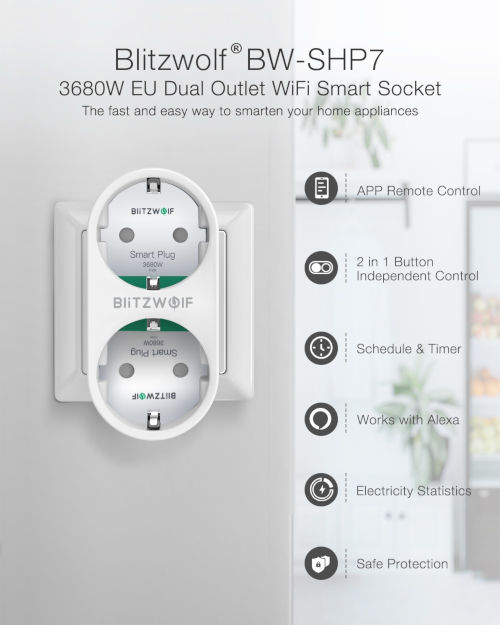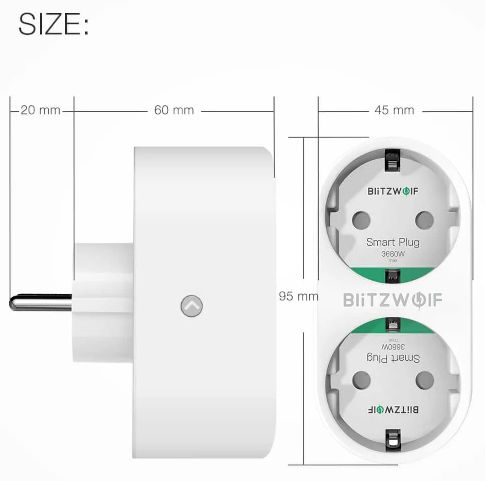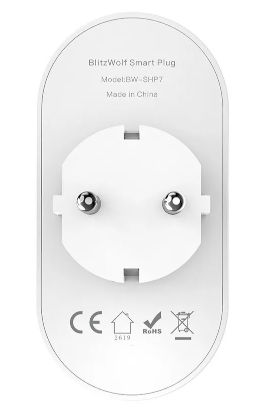Blitzwolf BW-SHP7 Double socket with powermonitoring



Model reference: BW-SHP7
Manufacturer: BlitzWolf
GPIO Pinout
| Pin | Function |
|---|---|
| GPIO00 | Button1 (pullup, inverted) |
| GPIO12 | Button2 (pullup, inverted) |
| GPIO13 | Red LED1(inverted) |
| GPIO02 | Red LED2(inverted) |
| GPIO14 | Relay1 |
| GPIO16 | Relay2 |
| GPIO01 | Blue LED (inverted) |
| GPIO03 | HLW8012 - SEL |
| GPIO04 | HLW8012 - CF |
| GPIO05 | HLW8012 - CF1 |
Basic Config
The configuration has some default sensors for wifi reporting etc. Some SHP7 devices experiences unexpected reboots after few minutes from start. By adding some config for GPIO15 it is solved.
substitutions:
device_name: shp7
# Higher value gives lower watt readout
current_res: '0.002291'
# Lower value gives lower voltage readout
voltage_div: '940'
# BW-SHP7, dual outlet with powermonitoring.
# One button for each relay, and one red led for each relay, as well as a blue status led
# Static IP is configured, and fast_connect is enabled, as the SSID is hidden
# Webserver is active and pw protected, and the OTA is password protected
esphome:
name: '${device_name}'
esp8266:
board: esp8285
wifi:
ssid: !secret wifi_ssid
password: !secret wifi_password
ap:
logger:
baud_rate: 0
api:
ota:
password: !secret otapw
# Button configuration
binary_sensor:
- platform: gpio
id: button1
name: button1
internal: true
pin:
number: GPIO0
mode: INPUT_PULLUP
inverted: true
on_press:
- switch.toggle: relay1
- platform: gpio
id: button2
name: button2
internal: true
pin:
number: GPIO12
mode: INPUT_PULLUP
inverted: true
on_press:
- switch.toggle: relay2
- platform: gpio
pin: GPIO15
id: gpio15_irq
internal: true
# Setup of LED's used in displaying LED status
output:
- platform: esp8266_pwm
id: led1
pin:
number: GPIO13
inverted: true
- platform: esp8266_pwm
id: led2
pin:
number: GPIO2
inverted: true
# Config for switches
switch:
- platform: gpio
pin: GPIO14
id: relay1
name: 'relay1'
on_turn_on:
- output.turn_on: led1
on_turn_off:
- output.turn_off: led1
- platform: gpio
pin: GPIO16
id: relay2
name: 'relay2'
on_turn_on:
- output.turn_on: led2
on_turn_off:
- output.turn_off: led2
# Status LED for connection
status_led:
pin:
number: GPIO01
inverted: true
# Sensors for WIFI signal strength, Uptime, Voltage, Current, Power, Daily energy usage
sensor:
- platform: hlw8012
sel_pin:
number: GPIO03
inverted: true
cf_pin: GPIO04
cf1_pin: GPIO05
current_resistor: ${current_res}
voltage_divider: ${voltage_div}
current:
name: '${device_name} current'
unit_of_measurement: 'A'
accuracy_decimals: 3
icon: mdi:flash-outline
voltage:
name: '${device_name} voltage'
unit_of_measurement: 'V'
icon: mdi:flash-outline
power:
name: '${device_name} power'
unit_of_measurement: 'kW'
id: power
accuracy_decimals: 3
filters:
- multiply: 0.001
icon: mdi:flash-outline
change_mode_every: 4
update_interval: 10s
- platform: total_daily_energy
name: '${device_name} daily energy'
power_id: power
unit_of_measurement: kWh
accuracy_decimals: 5
Advanced config additions
Starting with ESPHome v1.16.1 the hlw8012 platform sensor now supports energy, so we can add the following to the
hlw8012 platform sensor and get rid of the total_daily_energy platform sensor and the homeassistant time sensor:
sensor:
- platform: hlw8012
energy:
name: "${device_name} Energy"
unit_of_measurement: "Wh"
icon: mdi:flash-outline
In the esphome section, you can perform actions when the device boots:
on_boot:
then:
- switch.turn_on: relay1
# - switch.turn_on: relay2
Under wifi this can be added, this will set up static IP, allow the device to connect to a hidden SSID (fast_connect) and create a backup AP
wifi:
reboot_timeout: 60min
manual_ip:
static_ip: 192.168.1.100
gateway: 192.168.1.1
subnet: 255.255.255.0
fast_connect: true
# Enable fallback hotspot (captive portal) in case wifi connection fails
ap:
ssid: "${device_name} Hotspot"
password: !secret appw
This wll activate the internal webserver with password protection
web_server:
port: 80
auth:
username: !secret webuser
password: !secret webpw
To set time locally to the same as on the HomeAssistant (better logging)
# Sets time from Homeassistant
time:
- platform: homeassistant
id: homeassistant_time
To have different data shown for the device (ESPHome version) and the wifi. Will appear as sensors in HA.
# Sensors for ESP version and WIFI information
text_sensor:
- platform: version
name: "${device_name} ESPHome Version"
- platform: wifi_info
ip_address:
name: "${device_name} ip"
ssid:
name: "${device_name} ssid"
This will create sensors so that you can track wifi coverage for the devices, and also note the uptime for the devices.
sensors:
- platform: wifi_signal
name: '${device_name} WiFi Signal'
update_interval: 60s
accuracy_decimals: 0
- platform: uptime
name: '${device_name} Uptime'
unit_of_measurement: days
update_interval: 300s
accuracy_decimals: 1
filters:
- multiply: 0.000011574